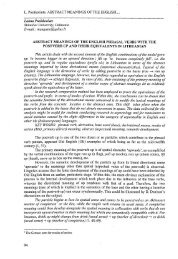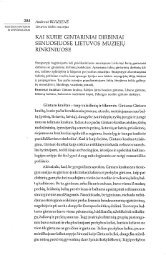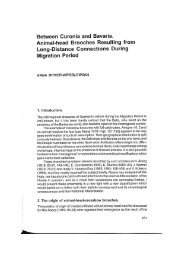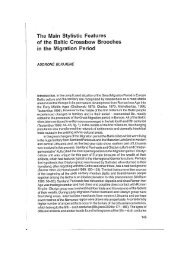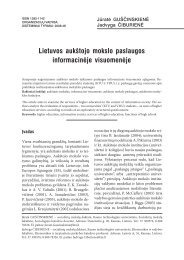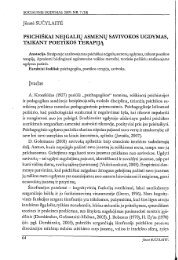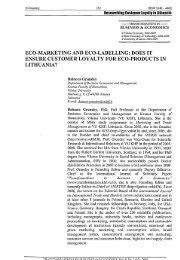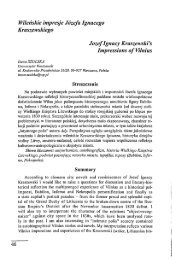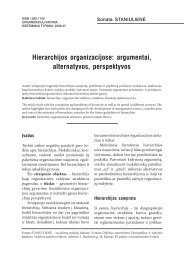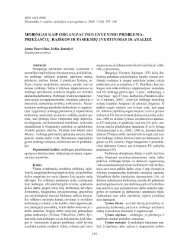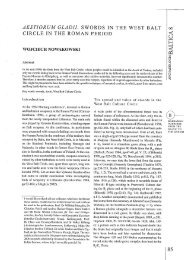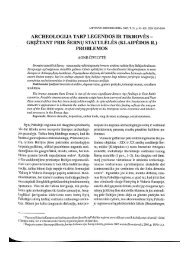15141.pdf
15141.pdf
15141.pdf
You also want an ePaper? Increase the reach of your titles
YUMPU automatically turns print PDFs into web optimized ePapers that Google loves.
FOLLOWING THE TRACES OF THE LOST o><br />
ĖGLIŠKIAI-ANDULIAI CURONIAN CEMETERY <<br />
t—i<br />
Й<br />
ANNA BITNER-WRÓBLEWSKA, AUDRONĖ BLIUJIENĖ AND <<br />
WOJCIECH WRÓBLEWSKI SP<br />
5 о<br />
о<br />
Abstract I w<br />
The Ėgliškiai-Anduliai cemetery is the largest Curonian burial site ever researched. However, during the Second World ^<br />
War this cemetery's artefacts and archival material were scattered throughout museums, archives and various institutions in <<br />
several countries. In this article, the authors present an intricate reconstruction of this burial monument based only on the<br />
surviving archival material of the research by German archaeologists, and only on a small collection of artefacts, as well as<br />
the research by Lithuanian archaeologists in recent years.<br />
Key words: Ėgliškiai-Anduliai cemetery, Curonians, west Lithuania, archives.<br />
Introduction<br />
Lithuania has archaeological sites whose fate, for<br />
many different reasons, oscillates between grandeur<br />
and merciless loss. One such site is the Ėgliškiai-<br />
Anduliai (Kretinga district) cemetery', better known in<br />
Lithuanian and other countries' historiographies as the<br />
Anduliai, Anduln, Andullen or Zeipen Gorge cemetery.<br />
This burial site is also known as the Stanz-Schlaudern<br />
(currently Toliai) or Eglin Niclau, Eglischken (current<br />
ly Ėgliškės) cemetery.<br />
The exceptional nature of the Ėgliškiai-Anduliai cemetery<br />
is determined by the significance of its material<br />
both to the Lithuanian coast and to the entire east Baltic<br />
region. In the opinion of some researchers of the first<br />
half of the 20th century, the so-called Memel Kultur is<br />
impossible to fully comprehend due to the fragmentary<br />
publication of its sites and the unpublished material of<br />
the Anduliai cemetery (Spicyn 1925: p. 142). Even today,<br />
this burial site is the largest ever researched West<br />
Lithuanian Stone Circle Grave Culture area and Curonian<br />
burial monument, which was used continuously<br />
for burials for more than 1,000 years. The earliest<br />
1<br />
The authors of this article are preparing to publish the material<br />
from the Ėgliškiai-Anduliai cemetery, basing their<br />
publication on the remaining archives and several dozen<br />
prewar artefacts, as well as on research by Lithuanian archaeologists.<br />
The research into the cemetery's material<br />
and the publication are a part of the international project<br />
"The Returning History of the Ėgliškiai-Anduliai Cemetery",<br />
initiated by the Kommission zur Erforschung von<br />
Sammlungen Archäologischer Funde und Unterlagen aus<br />
dem Nordöstlichen Mitteleuropa (KAFU). The surviving<br />
Ėgliškiai-Anduliai material (63 artefacts), inventory<br />
books, and archive are housed in the Museum für Vor-und<br />
Frügeschichte Staatliche Museen zu Berlin (henceforth<br />
referred to as MVF; formerly known as Konigliscb.cn Museum<br />
für Völkerkunde).<br />
known graves in the cemetery are dated to the end of<br />
the second century, while the very last Curonian cremations<br />
reach the first half of the 13th century. Since<br />
the end of the 19th century, including also the 2002 excavations,<br />
approximately 800 graves in the Ėgliškiai-<br />
Anduliai cemetery have been excavated. However,<br />
we will never find out the exact number of excavated<br />
graves, since apparently the unpublished research material<br />
of Adalbert Bezzenberger 2<br />
and Georg Reinhold<br />
Frölich, as well as the isolated finds that made their<br />
way to the Memel Landesmusemum (Klaipėda Land<br />
Museum from 1924, now the Lithuanian Minor History<br />
Museum) have been lost forever (Tables 1, 2).<br />
It is as if the Ėgliškiai-Anduliai cemetery has been<br />
marked by fate for a whole series of losses, some of<br />
which are irreversible. Evidently, the Prussia Museum's<br />
material that had been in Königsberg (now<br />
Kaliningrad) is among these permanent losses. About<br />
7,000 items from this burial site were housed in the<br />
ethnology museum in Berlin (Königlischen Museum<br />
für Völkerkunde); all of the material was taken to<br />
Moscow in 1945 as a consequence of the war, and is<br />
currently preserved in the State Historical Museum,<br />
Moscow (Bertram 2007: p.264). While it is a true pity,<br />
the political realities of Europe today block the way<br />
to researching or at least becoming acquainted with<br />
the material from this burial site in Moscow. The fate<br />
of the Insterburg (now Cherniakhovsk) Museum material<br />
is unclear. The reference points used by earlier<br />
researchers have disappeared in the unfamiliar and<br />
2<br />
Only a small portion of Bezzenbergcr's research material<br />
has survived in the Kaliningrad Region History and Art<br />
Museum. Unfortunately, the Ėgliškiai-Anduliai cemetery<br />
material was not found among the artefacts of Kaliningrad<br />
Fort III (Quednau). It could be that this material virtually<br />
cannot be identified any more.
changed surroundings. Thus, today scientists have a<br />
great many problems relating known archival data with<br />
the newest investigations. However, we would like<br />
to emphasise that successive work and our kind col<br />
leagues V. Vaitkevičius and J. Žikulinas 3<br />
have helped<br />
us to eventually connect all archive data, to locate plots<br />
excavated by Alfred Götze and Michel Martin Blyze,<br />
the owner of the land (except the plots investigated by<br />
A. Bezzenberger), and to lay it out in a totally shifting<br />
landscape (Plate VIII:1).<br />
Investigations and losses<br />
The Ėgliškiai-Anduliai cemetery was on the border between<br />
two states, first between Germany and Russia,<br />
and then between Lithuania and Germany. This fact<br />
has determined its research material's placement in<br />
the mentioned Berlin Museum as well as the Königsberg<br />
Prussia and Insterburg museums (Table 2). The<br />
cemetery is on the left bank of the River Akmena, on<br />
a scenic hill between the right bank of the Käpupis<br />
rivulet and the left bank of the Šaltupis rivulet. The<br />
etymology of Käpupis 4<br />
is associated with the cult river<br />
name of an environment touched by humans (Pėteraitis<br />
1992 p. 103, 237, Plate VIII.T). It is obvious that the<br />
river's name is related to the words käpas (which<br />
means "grave") and kapai (graves) and originated from<br />
the area's consistent use for cemeteries. To the north,<br />
the cemetery is adjacent to Early Iron Age cremation<br />
graves in urns, encircled by interconnected stone circles,<br />
and, apparently, by barrows that had been on the<br />
Šaltupis. To the south, the cemetery comes close to the<br />
Anduliai hill-fort, which twists around in a southeast<br />
direction. The hill-fort was called Scweden-Shancz or<br />
Alte Schanze at the end ofthe 19th and the beginning<br />
of the 20th centuries, and is now known as Pilalė. The<br />
eastern boundary of the cemetery so far remains uncertain<br />
(Plate VIII: 1). In the west, the Ėgliškiai-Anduliai<br />
cemetery's boundary ought to coincide with the slope<br />
of the terrace of the Akmena (Plate VIII:1; Fig. 1;<br />
Plate VIII:2). A natural protuberance known as a sacrificial<br />
hill (alkakalnis) is also part of the Ėgliškiai-<br />
Anduliai site complex. This hill is called Thunder<br />
3<br />
4<br />
We would like to express our gratitude to our colleagues<br />
V. Vaitkevičius PhD and I. Žikulinas for access to archive<br />
data and for the map. See Fig. 1.<br />
The Käpupis rivulet is fading from maps recently published<br />
in Lithuania, because the Šaltupis is indicated as the<br />
Käpupis. It is a pity that this hydronym has totally vanished<br />
from people's memory as a result of the change of<br />
population. The Šaltupis rivulet disappeared after land reclamation,<br />
but its name went to the nearby river, the Käpupis.<br />
Unconverted names of both rivulets arc indicated in<br />
19th-century maps, in Pėteraitis' study (Pėteraitis 1992, p.<br />
03, 237, Fig. 1), and in the maps prepared by specialists at<br />
the Lithuanian Heritage Protection Department.<br />
Hill (Perkūno kalnas in Lithuanian, Donnersberg in<br />
German) (Tautavičius 1963: pp.4-6). As is appropriate<br />
for sites established along the Käpupis stream, this<br />
archaeological complex's history concludes with the<br />
Ėgliškiai village's Evangelical Lutheran graveyard that<br />
was used up until 1950; the graveyard was called "the<br />
red one" after the red clay that was found while digging<br />
graves for the dead. Based on the stories of relatives,<br />
Michel Martin Blyze (1862-1927), a researcher<br />
into the Anduliai cemetery, is also buried here.<br />
As has been mentioned, the cemetery was on the land of<br />
three villages: Anduliai, Ėgliškiai and Stanz-Schlaudern<br />
(Tahlen, Thaluten-Stanz). This circumstance was the<br />
cause not only of the cemetery's abundance of names<br />
in archaeological literature, but also of some confusion<br />
(Plate VIII: 1; Fig. 1). On top ofthat, an annoying spelling<br />
error introduced another point of confusion for the<br />
Ėgliškiai-Anduliai cemetery, because the part of the<br />
cemetery that was in the Stanz-Schlaudern village's<br />
fields began to be called the Stranz-Schlaudern cemetery<br />
in archaeological literature (Moora 1938 p.100,<br />
187, pp.235-296, 309, 311, 381, 382, 447, Figs. 29. 8,<br />
30. 8, 9, 10, 13). That the Stanz-Schlaudern cemetery<br />
is the same as the Anduliai cemetery was mentioned by<br />
Joachim Hoffmann in 1941 (Hoffmann 1941 p.149).<br />
Thus we have three villages and one cemetery. While<br />
implementing administrative-territorial reform around<br />
1896, the village's name of Zeipen Gorge (Gerge, Kaulen-Görge,<br />
Kiaul-Urban), which was known since at<br />
least 1785, was changed to Anduliai (LVIA, Fund 1417,<br />
inventory 1, file 51; Gause 1935 p. 120; Pėteraitis, Purvinas<br />
2000 p.56). The Anduliai village does not exist<br />
any more (Noreika, Stravinskas 1976 p.9). Not only<br />
did the cemetery border three villages, but its huge territory<br />
was also under the domain of three landowners.<br />
The main part of the cemetery apparently belonged to<br />
Blyze; he researched it extensively for a high fee 5<br />
and<br />
sent the excavated grave artefacts and so-called "excavated<br />
plot plans or schemes" to Berlin's Königlischen<br />
Museum für Völkerkunde (Fig. 2, Table 1). Blyze clearly<br />
did not write research reports, so the only source of<br />
his research is the mentioned excavated plot plans, in<br />
which the graves' numbers are not always indicated.<br />
In his plans, Blyze always indicates the pathway in the<br />
north of this estate (Fig. 4). The scientific processing of<br />
the material Blyze sent (summarised grave inventories,<br />
schematic artefact drawings, a file) was done in the museum.<br />
When sending the excavated grave material to<br />
Berlin, Blyze usually indicated that these were graves<br />
found in the village of Anduln. Sometimes he would<br />
write that his researched material was from Eglin Niklau,<br />
and at other times that the graves were from the<br />
5<br />
Blyze received approximately 3,000 marks for his investi<br />
gations.
village of Eglischken. Now it is no longer possible to<br />
say whether this was related to the adjoining villages'<br />
boundaries or to some other reason. However, Blyze<br />
excavated almost the entire land around his farmstead.<br />
He also investigated the area between the three buildings<br />
comprising the farmstead. Judging from the archive,<br />
Blyze excavated 4,597 square metres and found<br />
341 graves. Alfred Götze mentions the material from<br />
533 graves in the Berlin museum (Götze 1908 p.489) 6<br />
.<br />
Evidently, in seeing the excavations by German archaeologists,<br />
Blyze also dug rather regular plots in<br />
which he would mark the number of graves (Fig. 2). In<br />
addition, judging from the M VF inventory book, Blyze<br />
distinguished the grave complexes well. But in placing<br />
Blyze's schematic plot plans next to each other, it is<br />
clear that some of the marked plots overlap each other.<br />
Although Blyze indicates certain distances between the<br />
situational schemes, they do not have linear scales. The<br />
most important point, however, is that today his chosen<br />
reference points are no longer clear. Not a single one<br />
of the former landowners' farmsteads or smaller field<br />
roads or larger roads that had connected the villages<br />
has survived (Plate VIII: 1; Plate VIII:2). In 1970, the<br />
cemetery's hill was altered, which changed unrecognisably<br />
the former surroundings. Due to the sketchiness<br />
of the recorded plots, it was not easy to coordinate<br />
them with each other or to tie them to the relief of the<br />
totally changed landscape.<br />
It would appear that in 1906, Blyze finished his investigations<br />
of the cemetery. However, isolated artefacts<br />
were also found in the 1920s while either ploughing<br />
the land or carrying out research, since it is known that<br />
a farmer from Ėgliškiai called M. Blyžė (apparently the<br />
cemetery's investigator's son) sold several ornaments<br />
found in this burial site to the Memel Landesmuseum<br />
(inventory book No 5583/1411-1414) (Table 2).<br />
We know from the investigations by the famous German<br />
archaeologist Alfred Götze (1865-1948) that the<br />
cemetery's western part belonged to the least distinguished<br />
person in this burial site's excavations, Janis<br />
Esins from the village of Ėgliškiai. But in 1895, the<br />
farmer Michel Broszeitis, whose land or a part of it<br />
was in the fields of Stanz-Schlaudem or the current<br />
village of Toliai, began researching the Ėgliškiai-<br />
Anduliai cemetery. Neither Esins nor Broszeitis drew<br />
plans of their research, nor did they write or send to<br />
Berlin any information, so the areas they excavated are<br />
6<br />
A well-prepared excavation report by Götze is preserved<br />
in the MVF (excavated plot plans with a layout of the<br />
graves and artefacts within them, and drawings of separate<br />
graves). However, the general locality map is schematic,<br />
without a linear scale. Götze, as well as Blyze, marks pathways<br />
north of the estate, and some other small pathways,<br />
which do not exist today, but are marked on the map published<br />
in 1912.<br />
totally unclear. They simply excavated and collected<br />
artefacts, which they sent to Berlin for a fee. Broszeitis<br />
was the first of the landowners to send various artefacts<br />
to the Königlischen Museum für Völkerkunde from the<br />
the village of Stanz-Schlaudern (MVF Acta I a 1295,<br />
1471/95). The artefacts he sent so interested the museum's<br />
assistant director Alfred Götze that he decided<br />
to go to Anduliai and start researching the cemetery.<br />
On 23-28 September 1895, Götze excavated the cemetery<br />
that so interested him, as well as one of the burial<br />
mounds in the barrow cemetery of Ėgliškiai that was<br />
closest to the Ėgliškiai-Anduliai cemetery (Götze<br />
1914: pp.85-87). Elena Grigalavičienė finished excavating<br />
the barrow that Götze started (Grigalavičienė<br />
1979: p.22, Fig. 30), while the last of the Ėgliškiai barrows<br />
were investigated by Ignas Jablonskis (Jablonskis<br />
1980, 1981).<br />
A 180-square-metre plot of Ėgliškiai-Anduliai was excavated<br />
in 1895, and 19 graves were discovered (MVF,<br />
Acta I a 1337/95; Götze 1908: p.489). Götze excavated<br />
the southeast of the cemetery, where he found seven<br />
Roman Period С phase graves (Fig. 5) 7<br />
. While investigating<br />
the northern part of the cemetery, he discovered<br />
inhumation and cremation graves of the E-H phases<br />
(MVF, Acta I a 1337/95, sheets 48-50). It is clear from<br />
Götze's excavated plots that these were only archaeological<br />
survey investigations, by which he wanted to<br />
establish the cemetery's boundaries, chronology and<br />
cultural affiliation.<br />
Evidently, the Prussia Museum and the Königlischen<br />
Museum für Völkerkunde were engaged in competition,<br />
trying to outdo each other in the accumulation<br />
of Memellgebiet collections. Such a presumption can<br />
be made by several facts related to this burial site. In<br />
1895, as soon as Götze's investigations were finished,<br />
A. Bezzenberger visited Berlin, where he examined the<br />
Anduln cemetery finds. In a letter to his assistant, Hugo<br />
Scheu, the Lėbartai estate owner (now within the city<br />
limits of Šilutė), he wrote that, as he had suspected, the<br />
things he had brought from the Zeipen-Görge cemetery<br />
were more characteristic of Memel Kultur and more<br />
attractive than the ones he had seen in Berlin (MAB<br />
RS, Fund 12-1239, sheet 14). Thus it is no surprise that<br />
Bezzenberger himself excavated the Ėgliškiai-Anduliai<br />
cemetery for a few years, although his investigations<br />
never lasted long (Tamulynas 1998: 267) (Table 1).<br />
Bezzenberger did not publish his investigations of the<br />
Ėgliškiai-Anduliai cemetery in a more extensive article,<br />
which is strange and not characteristic of him.<br />
However, the biggest problem is that Bezzenberger's<br />
7<br />
Thirty-three Roman coins were found in the cemetery,<br />
the earliest of which was of the Emperor Hadrian (117-<br />
138), and the latest Philip I (244-249). See MVF Acta la<br />
1337/90, sheets 50-51.
Fig. LA detail of a map published in 1912: Anduliai and Ėgliškės villages, the hill-fort (Alte Schanze) and the estates of<br />
Michel Martin Blyze and Michel Broszeitis.
------ £Ж /йЮ/зс.<br />
I •% JT.1-77-U-<br />
^ „г л//,. А- ,/
Fig. 3. Plots excavated by in 1895 by A. Götze, graves surrounded by stone circles (after the MVF archive).<br />
and around the cemetery's area. Some of the artefacts<br />
made their way to the Kretinga Museum, while several<br />
single finds ended up in the Lithuanian Art Museum<br />
and the Lithuanian National Museum (Table 2). The<br />
prominent local ethnographer and archaeologist Ignas<br />
Jablonskis submitted the grave goods from a Roman<br />
Period grave that was discovered in unclear circumstances.<br />
Among the artefacts that he submitted in 1987<br />
is a unique woman's breast ornament from the Roman<br />
Period, made out of bronze pendants, a portion<br />
of which are decorated with red enamel (Bitner-Wróblewska,<br />
Bliujienė 2003: pp.121-132). In 1972 a gas<br />
pipeline cut through the northern part of the cemetery,<br />
at which time approximately 20 mid-tenth to 12thcentury<br />
cremation graves and one inhumation grave<br />
were destroyed (Jablonskis 1974: pp.82-86). After the<br />
catastrophic destruction, the Kretinga ethnographer Ignas<br />
Jablonskis managed to record only the preserved<br />
graves or their remains.<br />
In 1988, Jablonskis, together with Donatas Butkus and<br />
Julius Kanarskas, returned once again to the investigation<br />
of the Ėgliškiai-Anduliai cemetery. At that time<br />
they excavated the northeast part of the cemetery. In<br />
a small, only 16.7-square-metre excavated plot, a late<br />
11th-century inhumation grave was found covered in<br />
four layers by 22 11th to 13th-century cremation graves<br />
(Kanarskas 1988). The dead that were buried there in<br />
several layers not only justify the origin of the name<br />
of the River Käpupis on whose bank the cemetery was<br />
founded, but also show that the communities of the An<br />
duliai environs buried their fellow countrymen at this<br />
burial site.<br />
While researching and preparing the Ėgliškiai-Anduliai<br />
cemetery material for publication, it became clear to<br />
this article's authors that information concerning the<br />
Roman Period's graves with stone circles is lacking<br />
among the known material. Thus, an effort was made<br />
to find the location of Götze's excavated Roman Period<br />
plots based on the known archival material (Fig. 3).<br />
On his map, Götze also marked excavated plots, the<br />
boundaries of former landowners' lands, field roads,<br />
and a hill-fort. Great success accompanied the excavations<br />
of 2002, since graves with stone circles dated to<br />
the turn of the third century were found further to the<br />
east of Götze's excavated plots (Bliujienė 2005, pp.93-<br />
96, Fig. 36) (Plate VIII:3).<br />
The old research results and<br />
possibilities for new interpretations<br />
Since a sizeable portion of the Ėgliškiai-Anduliai cemetery's<br />
artefacts was given over to the Königlischen<br />
Museum für Völkerkunde in Berlin, it became accessible<br />
to many researchers. The large number of investigated<br />
graves, based upon which generalisations can<br />
be made characterising the entire culture, as well as the<br />
.material's interregionality, attracted researchers to the<br />
Ėgliškiai-Anduliai cemetery material. That is why in
Fig. 4. The Ėgliškiai-Anduliai cemetery: grave goods of graves CCLXXII, CCLXXIV-CCLXXVI (after the MVF archive).
the first half of the 20th century, this Curonian burial<br />
site material, and Curonian Culture itself, till now, was<br />
mostly known through the burial site material (Götze<br />
1908, pp.481-500; Oxenstierna 1940, pp.249-252;<br />
Äberg 1919, pp.147-149, Figs. 201, 203; Kühn 1974,<br />
pp.878-889; Arwidsson 1977, pp.70-71; Bitner-Wróblewska,<br />
Wróblewski 2001, pp.19-33; Bitner-Wróblewska,<br />
Bliujienė, Wróblewski 2003, pp.185-210).<br />
The Baltic archaeologists Harri Moora, Marta Schmiedehelm,<br />
Feliks Jakobson and Jonas Puzinas were also<br />
interested in the Ėgliškiai-Anduliai cemetery (Table 3).<br />
Material on this significant site is in Nils Aberg's and<br />
Herbert Jankuhn's archival legacy (Table 3).<br />
Although only 20 Roman Period graves have been<br />
found, the period's graves could be one of the cornerstone<br />
reasons to return once again to the more than<br />
once analysed West Lithuanian Stone Circle Grave<br />
Culture area's source (Michelbertas 1986, pp.29-30;<br />
Žulkus 1995, pp.80-88). One of the main origin theories<br />
in Lithuania of the West Lithuanian Stone Circle<br />
Grave Culture area is the culture's appearance from<br />
the Early Iron Age's flattened barrows (Michelbertas<br />
1986, p.30). Still, despite the stone circles linking both<br />
chronological phases, and even the survival of single<br />
flattened barrows (Kašučiai and Padvariai) or the usage<br />
of Early Iron Age barrows to bury the deceased in<br />
the second half of the first century (Padvariai), in the<br />
second half of the first century to the end of the second<br />
century of the Roman Period, flat burial grounds with<br />
interconnected stone circles and inhumation burials<br />
of mostly northern orientation graves, and with constantly<br />
increasing grave goods, differ greatly from the<br />
earlier ones. Indeed, some Roman Period cemeteries<br />
were formed alongside previous barrows with cremation<br />
graves. But at the end of the second to the beginning<br />
of the third century (B 2/Cj phase), a large number<br />
of cemeteries were formed in altogether new places<br />
(Aukštkiemiai, Bandužiai, Rudaičiai II, Mazkatuži in<br />
Latvia, and others). The community that formed the<br />
Ėgliškiai-Anduliai cemetery's Roman Period B 2/C,<br />
phase cemetery started burying its dead at the opposite<br />
end of the hill, closer to the hill-fort, as if emphasising<br />
the non-existence of continuity with the earlier cremation<br />
graves. There is no doubt that the new cemeteries<br />
show an extensive expansion of coastal settlement.<br />
However, the Roman Period's material culture and elements<br />
of burial rites have almost no connections with<br />
the heritage left in the last centuries ВС and first decades<br />
AD. The appearance of male graves with riding<br />
horses, especially wealthy women's graves of an interregional<br />
character, and miniature ceramics, as well as<br />
the types of weapons and armament, riding gear, and<br />
ornaments, would show the connections of the people<br />
who left them with Dollkeim-Kovrovo Culture,<br />
Gotland, and other southeast Baltic Sea regions, rather<br />
than relations or a continuity with the former Early Iron<br />
Age Barrow Culture. On the other hand, the appearance<br />
of new cemeteries, changes in burial rites, and the<br />
rapid development of material culture could have been<br />
determined by the more extensive West Baits' cultural<br />
ties with Central and northern Europe.<br />
Till now the Ėgliškiai-Anduliai cemetery's horizontal<br />
stratigraphy does not allow for the determination<br />
of where the Roman Period graves end, and where the<br />
Migration Period graves and Late Curonian burials<br />
begin. But the sketchy plans left by researchers give<br />
the impression that the cemetery consistently spread<br />
from south to north. The smallest number of graves in<br />
the Ėgliškiai-Anduliai cemetery belonged to the Migration<br />
Period (Fig. 4). Judging by the material that<br />
was published in several tables, there was material<br />
from the Migration Period among the graves excavated<br />
by Frölich and Bezzenberger (Zeitschrift 1905,<br />
Plate X.37; Herbert Jankuhn's archive is kept in the<br />
Land Museum of Schleswig-Holstein), but the more<br />
precise quantity is unknown. Thus, in this respect, the<br />
Ėgliškiai-Anduliai cemetery, just like a large portion<br />
of southern Curonian burial sites, reflects the period's<br />
demographic crisis. However, the number of graves<br />
in the cemetery greatly increases in the first half of<br />
the seventh century (Fig. 5). At that time, Ėgliškiai-<br />
Anduliai, just like Lazdininkai (Kalnalaukis), Palanga,<br />
Genčai and Kašučiai, all become a part of the forming<br />
Curonians' Mėguva lands, as well as certain, perhaps<br />
not of equal importance, concentrations of power, and<br />
trade and commerce centres. The centres had ties with<br />
central Scandinavia and Gotland, as well as the people<br />
of Olsztyn groups (Bitner-Wróblewska, Wróblewski<br />
2001, pp.26-27, Figs. 3, 4; Bliujienė, Butkus 2001,<br />
pp.83-95; Bliujienė, Butkus 2006, pp.13-17, Figs. 1-7)<br />
(Fig. 6).<br />
The chronological problems of these days in Lithuanian<br />
archaeology remain among the most serious. Although<br />
in the last few decades more than one Curonian<br />
cemetery has been published, chronological problems<br />
are still analysed only in this culture's context, with no<br />
effort to synchronize them with the material of their<br />
closest or most distant neighbours. The huge extent<br />
of the Ėgliškiai-Anduliai cemetery's material and the<br />
grave complexes with unique material culture elements<br />
allow us not only to consider more seriously the<br />
chronological problems, but also to try to solve them.<br />
Several graves, interesting chronologically and culturally<br />
for their sets of grave goods, have been found<br />
in the cemetery. One such grave is grave CCLXXIV<br />
that connects, in an archaeological sense, female (a<br />
cruciform pin of Group III, traditionally dated to the
Fig. 5. The Ėgliškiai-Anduliai cemetery: grave goods of graves CCCXV, CCXVII (after the MVF archive).
Fig. 6. Lazdininkai (Kalnalaukis) (1), Ėgliškiai-Anduliai (2), Palanga (3), Pryšmančiai (4), Genčai (5) and Kašučiai (6)<br />
sites, their internecine relations and connections with central Scandinavia (after V. Žulkus 2004 and A. Bliujienė).
ninth and tenth century [Kuncienė 1978, p.84, Map<br />
49.3] and male (a square belt buckle with a square belt<br />
plate, traditionally dated to the eighth to 12th century<br />
[Butėnas 1999, p.48; Gintautaitė-Butėnienė, Butėnas<br />
2002, pp.50-52, Figs. 42-44]) grave goods, and most<br />
likely male grave goods (the only "Monsheim" type<br />
brooch known in Curonian lands so far, dated to the<br />
second half of the sixth century [Kühn 1974, pp.885-<br />
897, Fig. 37]) (Fig. 7). Today it is difficult to answer<br />
why Blyze sent precisely this grave good complex of<br />
grave CCLXXIV to Berlin. It could be that artefacts<br />
from cremation graves that had been above the earlier<br />
inhumation graves got "mixed up" in this complex. It is<br />
exactly multi-layered graves, where cremation graves<br />
from several different chronological phases covered an<br />
inhumation grave, that were discovered in 1988 in the<br />
Ėgliškiai-Anduliai cemetery (Kanarskas 1988, p.4, Fig.<br />
47). The investigation of Curonian cremation graves is<br />
a difficult nut to crack even for today's archaeologists,<br />
because this many-layered and multi-aspect nature<br />
of burial rites has not been researched much (Žulkus<br />
2004, p. 161 -179; Bliujienė 2005a, pp. 147-162). Curonian<br />
cremation graves could also have been too difficult<br />
to crack for Blyze, an amateur archaeologist. But<br />
it could also be that the chronology of the grave good<br />
complex of grave CCLXXIV and the dating of the cruciform<br />
pin will be adjusted without analysing all the<br />
known material of the Ėgliškiai-Anduliai cemetery.<br />
Based on Jablonskis' research, the people who left the<br />
Ėgliškiai-Anduliai cemetery always lived close by (Jablonskis<br />
1982). The small plot excavated in the hill-fort<br />
allows for a date of not earlier than the beginning of<br />
the second millennium (Švelniūtė 2005, p.51). So what<br />
was on the protuberance on the bank of the Käpupis up<br />
until the hill's use as a habitation or more likely a defensive<br />
area associated with the Kretinga castle mentioned<br />
in 1253 and burned down by the Livonian Order<br />
in 1263 (Livlaendisches 1853, pp.319-320, 416-417;<br />
Baubonis, Zabiela 2005, p.438). It could be that the<br />
protuberance that had been on the bank of the Käpupis<br />
in one way or another was related to burial rituals<br />
such as cremation and other pagan rites. The sacrificial<br />
hill called Thunderer Hill indirectly bears testimony to<br />
such former rites (Tautavičius 1963, p.5; Vaitkevičius<br />
2003, p.50).<br />
Conclusions<br />
The main question that the authors of this article have<br />
raised more than once is, is it worth putting so much<br />
effort into researching a cemetery when one has only<br />
63 artefacts that survived from pre-Second World War<br />
research, inventoriai books, a file with a description<br />
of the graves and schematic artefact drawings from<br />
the turn of the 20th century, an archive, fragmentary<br />
data from recent years, and till now not easy to access<br />
artefacts of pre-war research. This article's authors<br />
think that, despite the fragmentary descriptions of<br />
graves and schematic artefact drawings, the recorded<br />
material corresponds to past reality, which can be adjusted<br />
when relating it to the artefacts that have survived<br />
(Bitner-Wróblewska, Wróblewski 2001, Fig. 4.<br />
а, с, f). Since the Second World War, similar coastal<br />
sites with long chronologies have been researched in<br />
Lithuania; in one way or another these sites supplement<br />
the more difficult to understand burial rite features<br />
and grave complexes, or even separate artefacts<br />
of the Ėgliškiai-Anduliai cemetery. With its archives<br />
scattered throughout various institutions, the notes of<br />
various researchers supplement each other. Thus, the<br />
Ėgliškiai-Anduliai cemetery material is slowly turning<br />
into a whole from being a mosaic. Based on the<br />
most varied archival material, step by step, 500 graves<br />
with full summaries and sketchy but understandable illustrations<br />
have been reconstructed (Figs. 4, 5). This<br />
database is further supplemented by material from<br />
Lithuanian archaeological investigations at this burial<br />
site. This article's authors believe that in the coordination<br />
of all known data, including bioanthropological<br />
and palaeozoological (Lithuanian archaeological research)<br />
with nondestructive research methods, the set<br />
goal will be accomplished: to reconstruct the Ėgliškiai-<br />
Anduliai cemetery material and, based on this data, to<br />
examine the community that changed over 1,000 years<br />
and that left it behind.<br />
Translated by Indrė Antanaitis-Jacobs<br />
Table 1. Researchers of the Ėgliškiai-<br />
Anduliai cemetery<br />
Year Researchers<br />
1895-1908; until<br />
1945?<br />
Landowners: Michel Broszeitis,<br />
Michel Martin Blyze, Janis Esins<br />
1895,1903? Dr Alfred Götze, Berlin<br />
1897, 1899, 1902 Georg Reinhold Frölich, Insterburg<br />
1895, 1901, 1903,<br />
1906-1908<br />
1896-1901, 1903,<br />
1905,1906<br />
1963<br />
1972<br />
1987<br />
1988<br />
1963-1990 and<br />
later<br />
2002<br />
2006<br />
Adalbert Bezzenberger, Königsberg<br />
Landowner Michel Martin Blyze<br />
Lithuanian History Institute<br />
archaeological surveys<br />
Ignas Jablonskis<br />
Lithuanian Art Museum surveys<br />
Ignas Jablonskis, Donatas Butkus and<br />
Julius Kanarskas<br />
Isolated artefacts found on the surface<br />
Audronė Bliujienė<br />
Geoprospecting of a part of the<br />
cemetery by Dr Immo Heske and<br />
Martin Prossclt, Germany<br />
0\<br />
<<br />
О<br />
i—i<br />
<<br />
<<br />
о<br />
о H-J о<br />
w<br />
<<br />
X<br />
и<br />
oś<br />
Table 2. Ėgliškiai-Anduliai cemetery<br />
artefacts and their survival<br />
Artefacts Surviving artefacts and place<br />
curated<br />
MVF (former<br />
Königlischen Museum<br />
für Völkerkunde), Berlin<br />
Insterburg (now<br />
Cherniahovsk,<br />
Kaliningrad region)<br />
Museum<br />
Prussia Museum<br />
(Königsberg)<br />
Landesmuseum<br />
Memel (Klaipėda Land<br />
Museum from 1924;<br />
now Lithuanian Minor<br />
History Museum)<br />
State Historical Museum<br />
in Moscow<br />
About 63 artefacts, inventoriai<br />
books with illustrations and<br />
inventories, file, archive<br />
A portion of the artefacts<br />
might have survived at Halle<br />
University's Prehistory<br />
Institute (Germany)<br />
Kaliningrad: no data (did not<br />
survive?); 1 artefact in Berlin<br />
Did not survive<br />
Anduln material more than<br />
7,000 catalogue entries, except<br />
63 artefacts, from MVF were<br />
displaced to the State Historical<br />
Museum in Moscow as a<br />
consequence of war<br />
Kretinga Museum Kr. M GEK 10820/1-57; Kr.M<br />
LS 1876/1-295<br />
Lithuanian Art Museum LDM ED 132124; PGM PMAp<br />
4859-4861; 5401<br />
Lithuanian National<br />
Museum<br />
LNM GRD 25487/1-2<br />
Table 3. Archives into which<br />
documents and artefact illustrations<br />
from the Ėgliškiai-Anduliai cemetery<br />
were placed<br />
Institution Place curated<br />
Museum für Vor- und<br />
Frühgeschichte archive<br />
MVF Berlin<br />
Prussia Museum archive MVF Berlin (1 sheet)<br />
Feliks Jäkobson's archive National History Museum of<br />
Latvia; Riga, Latvia<br />
Herbert Jankuhn's<br />
archive<br />
Museum of the Land<br />
of Schleswig-Holstein;<br />
Schleswig, Germany (1 sheet)<br />
Nils Äberg's archive National Heritage Council,<br />
Antiquarian Archive,<br />
Stockholm, Sweden<br />
Jonas Puzinas' archive Lithuanian National M.<br />
Mažvydas Library<br />
Lithuanian museums Klaipėda, Kretinga, Palanga,<br />
Vilnius, Kaunas<br />
Lithuanian History<br />
Institute<br />
Vilnius<br />
Estonian History Institute Tallinn<br />
Abbreviations<br />
Jahresbericht - Jahresbericht der Altertumsgesells<br />
chaft zu Insterburg für das Vereinsjahr 1902, Inster<br />
burg, 1902<br />
Festschrift - Festschrift zum 25-jährigen Jubiläum der<br />
Altertumsgesellschaft Insterburg, Insterburg, 1905<br />
Livlaendisches Urkundeuch, Reval, I. Reval, 1853<br />
LVIA - The Lithuanian State History Archive, Vilnius<br />
Lietuvos - Lietuvos TSR archeologijos atlasas, Viln<br />
ius, 1977<br />
MAB RS - Lithuanian Academy of Sciences, Depart<br />
ment of Rare Publications, Vilnius<br />
MVF - Museum für Vor- und Frügeschichte Staatliche<br />
Museen zu Berlin (formerly Königlischen Museum für<br />
Völkerkunde), Berlin<br />
References<br />
Manuscripts<br />
MAB RS - A. Bezzenberger's letters to H. Scheu and other<br />
Lithuanian philological material 1895. In: Lithuanian<br />
Academy of Sciences, Department of Rare Publications,<br />
MAB RS, Fund 12-1239.<br />
JABLONSKIS, L, 1980-1981. Ėgliškių-Andulių pilkapių<br />
tyrinėjimai 1980 ir 1981 m. tyrinėjimai. In: Archive of<br />
Lithuanian Institute of History, Fund 1, files 786, 815.<br />
JABLONSKIS, I., 1982. Ėgliškių, Kalno Grikštų (Kretingos<br />
raj.), Žvelsėnų (Klaipėdos raj.) priešistorinės gyvenvietės.<br />
In: Archive of Lithuanian Institute of History, Fund 1, file<br />
693.<br />
Lithuania Minor History Museum, inventoriai book, Inv. Nr.<br />
5583/1411-1414.<br />
LVIA - Dritte Abtheilung Hypotheken und Grundschulden<br />
1808-1944. In: LVIA, Fund 1417, inventory 1, file 51.<br />
KANARSKAS, J., 1988. Andulių (Kretingos raj., Žalgirio<br />
apyl.) plokštinio kapinyno 1988 metų tyrinėjimai. //;: Archive<br />
of Lithuanian Institute of History, Fund 1, file 1736.<br />
TAUTAVIČIUS, A., 1963. Archaeological survey report of<br />
the Kretinga, Klaipėda, Šilutė, and Tauragė/Jurbarkas districts,<br />
8-28 May 1963. In: Archive of Lithuanian Institute<br />
of History, Fund 1, file 187-187a.<br />
Literature<br />
ÄBERG, N., 1919. Ostprenssen in der Völkerwanderungszeit.<br />
Uppsala, Leipzig: A.-B. Akademiška Bokhandeln and<br />
Otto Harrassowitz.<br />
ARWIDSSON, G., 1977. Valsgärde 7, Die Gräberfunde von<br />
Valsgärde III. Acta Musei Antiquitatum Septentrionalium<br />
Regiae Universitatis Upsaliensis, V. Uppsala.<br />
BAUBONIS, Z., ZABIELA, G. (compilers), 2005. Lietuvos<br />
piliakalniai. Atlasas, I. Vilnius.<br />
BERTRAM, M., 2007. The History of the Merovingian Period<br />
and Merovingian collection in the Museum für Vor- und<br />
Frühgeschichte in Berlin. In: The Merovingian Period. Eu-
ope without Borders. Archaeology and history of the 5th<br />
to 8th centuries. Staatliche Museen zu Berlin: Staatliche<br />
Museen zu Berlin, 254-270.<br />
BITNER-WRÓBLEWSKA, A., WRÓBLEWSKI, W, 2001.<br />
Unikatowe okucia rogów do picia z okresu Vendel z cmentarzysk<br />
w Anduln/Anduliai (zachodnia Litwa) i Valsgärde<br />
(środkowa Szwecja). //;: W NOWAKOWSKI and A. SZE-<br />
LA(eds.), Officina archaelogica optima, Studia ofiarowane<br />
Jerzemu Okuliczowi-Kozarynowi w siedemdziątą rocznicę<br />
urodzin, Swiatowit. Supplement Series P: Prehistory and<br />
Middle Ages, 7. Warsawa, 19-33.<br />
BITNER-WRÓBLEWSKA, A., BLIUJIENĖ, A., 2003.<br />
Efektowny napierśnik z emalią z cmentarzyska w Anduln,<br />
zachodnia Litwa. In: A. BURSCHE and R. CIOŁEK<br />
(eds.), Antyk i Barbarzyńcy. Księga dedykowana profesorowi<br />
Jerzemu Kolendo w siedemdziesiątąrocznicę urodzin.<br />
Warszawa, 121-132.<br />
BITNER-WRÓBLEWSKA, A., BLIUJIENĖ, A., WRÓ<br />
BLEWSKI, W, 2003. Das „verlorene" Gräberfeld von<br />
Anduln, Memelgebiet (heute Ėgliškiai-Anduliai, West-<br />
Litauen). Ein Wiedergewinnungsversuch. Acta Prachistorica<br />
et Archaeologica 35, 185-210.<br />
BLIUJIENĖ, A., 2005. Ėgliškių-Andulių kapinynas. In: Archeologiniai<br />
tyrinėjimai Lietuvoje 2002 metais. Vilnius:<br />
Diemedžio leidykla, 93-96.<br />
BLIUJIENĖ, A., 2005a. Pottery in Curonian Creamtion<br />
Burials. Some Aspects of Interactions across the Baltic<br />
Sea in the Late Viking Age and Early Medieval Period. In:<br />
V. LANG (ed.), Interarchaeologia, I. Culture and Material<br />
Culture. Papers from the first theoretical seminar of<br />
the Baltic archaeologist (BASE) held at the University of<br />
Tartu, Estonia, October 17"' - 19"; 2003. Tartu - Riga -<br />
Vilnius, 147-166.<br />
BLIUJIENĖ, A., BUTKUS, D., 2001. VII a. pirmosios<br />
pusės karys iš Lazdininkų (Kalnalaukio). Archaeologia<br />
Lituana, 3, 83-95.<br />
BLIUJIENĖ, A., BUTKUS, D., 2006. Bronze Drinking Horn<br />
Terminals from the Kašučiai Cemetery in Western Lithuania<br />
as a Part of Lively Connections between Southern<br />
Curonia and Central Scandinavia. Swiatowit, VI (XLVII),<br />
13-17.<br />
BUTĖNAS, E., 1999. Sagtys iš Rytų Lietuvos pilkapių (tipai,<br />
paskirtis). Lietuvos archeologija, 18, 37-56.<br />
Festschrift zum 25-jährigen Jubiläum der Altertumsgesellschaft<br />
Insterburg, Insterburg, 1905.<br />
GAUSE, W, 1935. Neu Ortsnamen in Ostpreussen seit 1800.<br />
Verzeichnis der Anderunngen im Orstnamenbestand der<br />
Provinz Ostpreussen (alten Umfanges) seit dem Beginn<br />
des 19. Jahrhunderts. Königsberg.<br />
GINTAUTAITĖ-BUTĖNIENĖ, E., BUTĖNAS, E, 2002.<br />
Laivių kapinynas, Lietuvos archeologija, 22, 9-198.<br />
GÖTZE, A., 1908. Brettchenweberei im Altertum. Zeilschrift<br />
fiir Ethnologie, 40, 481-500.<br />
GÖTZE, A., 1914. Hügelbräbcr bei Eglien Niclau, Kreis Memel.<br />
Sitzungsberichte der Altertumsgesellchaff Prussia,<br />
23/1,85-87.<br />
GRIGALAVIČIENĖ, E., 1979. Egliškių pilkapiai. Lietuvos<br />
archeologija, 1, 5-43.<br />
HOFFMANN, J., 1941. Die spätheidnische Kultur des Memellandes<br />
(10.-12. Jahrh. n. d. Zw), Königsberg - Berlin.<br />
JABLONSKIS, I., 1974. Andulių-Krctingos senkapio radiniai.<br />
In: Archeologiniai ir etnografiniai tyrinėjimai Lietuvoje<br />
1972 ir 1973 metais. Vilnius, 82-86.<br />
Jahresbericht der Altcrtumsgescllschaft zu Insterburg Für das<br />
Vcrcinsjahr 1902, Insterburg, 1902.<br />
KUNCIENĖ, О., 1978. VIII-XIII a. kryžiniai smeigtukai. Lietuvos<br />
TSR archeologijos atlasas, IV. Vilnius, 83-87.<br />
KÜHN, H., 1974. Die germanischen Bügelfibeln der Völkerwanderungszeit,<br />
II Teil: Die germanischen Bügelfibeln der<br />
Völkerwanderungszeit in Süddeutschland, Graz.<br />
Lietuvos TSR archeologijos atlasas, III, Vilnius, 1977.<br />
NOREIKA, Z., STRAVINSKAS, V. (compilers), 1976. Lietuvos<br />
TSR administracinio teritorinio suskirstymo žinynas, I.<br />
Vilnius: Mintis.<br />
MICHELBERTAS, M., 1986. Senasis geležies amžius (I-IV<br />
amžius), Vilnius: Mokslas.<br />
MOORA, H., 1938. Die Eisenzeit in Lettland bis etwa 500 n.<br />
Chr. II Teil: Analyse. Tartu.<br />
OXENSTIERNA, GRAF E.C., 1940. Die Prachtfibel aus<br />
Grebin. Mannus, 32/1-2, 219-252.<br />
PĖTERAITIS,V., 1992. Mažoji Lietuva ir Tvanbtaprabalta<br />
pralietuvių ir lietuvininkų laikais. Vilnius: Mokslo ir<br />
enciklopedijų leidykla<br />
PĖTERAITIS, V, PURVINAS, M., 2000. Anduliai, Mažosios<br />
Lietuvos enciklopedija, I. Vilnius, 56.<br />
SPICYN, A.A., 1925. Litovskie drevnosti. Tauta ir žodis, 3.<br />
Kaunas, 121-171.<br />
TAMULYNAS, L., 1998. A. Bezzenbergerio archeologiniai<br />
tyrinėjimai Klaipėdos krašte, Lietuvos archeologija, 15,<br />
247-285.<br />
ŠVELNIUTĖ, R., 2005. Andulių piliakalnio priešpilis. In:<br />
Archeologiniai tyrinėjimai Lietuvoje 2003 metais. Vilnius:<br />
Diemedžio leidykla, 51-53.<br />
VAITKEVIČIUS, V, 2003. Alkai. Balių šventviečių studija,<br />
Vilnius: Diemedžio leidykla.<br />
ŽULKUS, V, 1995. Vakarų baltai gotų-gepidų migracijoje<br />
(I-IV a.). In: Lietuvininkų kraštas. Kaunas: Litterae Universitatis,<br />
65-107.<br />
ŽULKUS, V, 2005. Kuršiai Baltijos jūros erdvėje. Vilnius:<br />
Versus aureus.<br />
Received: 22 October 2007; Revised: 31 January 2008;<br />
Anna Bitner-Wróblewska<br />
State Archaeological Museum<br />
Dluga 52<br />
Warsaw<br />
POLAND<br />
a.bitner@pma.pl<br />
Audronė Bliujienė<br />
Institute of Baltic Sea Region History and Archaeology<br />
Klaipėda University<br />
Tilžės g. 13<br />
LT-91251 Klaipėda<br />
LITHUANIA<br />
audrone.bliujicne@ginail.com<br />
Wojciech Wróblewski<br />
Institute of Archaeology<br />
Warsaw University<br />
Krakowskie Przedmieście 26/28<br />
00-927 Warsaw<br />
POLAND<br />
wojcicch_wroblcwski@hotmail.com<br />
OS<br />
<<br />
О<br />
H—I<br />
Ö<br />
<<br />
<<br />
о<br />
о<br />
w<br />
<<br />
X<br />
и<br />
Pi<br />
K d i<br />
CA J o S<br />
Šio straipsnio autoriams tyrinėjant ir rengiant publi<br />
kacijai Ėgliškių-Andulių kapinyno medžiagą tapo aki<br />
vaizdu, kad tarp turimos medžiagos trūksta žinią apie<br />
šio laidojimo paminklo romėniškojo laikotarpio kapus<br />
su akmenų vainikais. Todėl remiantis turima archyvine<br />
medžiaga buvo bandyta surasti A. Götze's tyrinėtas ro<br />
mėniškojo laikotarpio perkasų vietas (5 pav.). Nors to<br />
padaryti nepavyko, bet 2002 metų tyrinėjimus lydėjo<br />
nemenka sėkmė, nes dar toliau į rytus nuo A. Götze's<br />
tirtų plotų buvo rasta kapų su akmenų vainikais, datuo<br />
jamų II a. pabaiga - III a. pradžia (Plate VIII:3).<br />
Šio straipsnio autoriai tyrinėja Ėgliškių-Andulių ka<br />
pinyno medžiagą, surinktą iki 1945 metų, remdamiesi<br />
archyvine medžiaga ir nedidele dalimi išlikusių radinių<br />
(4-5 pav.).
is whether the grave goods placed inside the burial with<br />
the deceased were the possessions of the deceased or of<br />
the mourners, or perhaps even heirlooms. The solution<br />
to this question would, according to the author, enable<br />
a determination of the deceased's social status, as well<br />
as the level of authority he held.<br />
The author devotes a chapter of the book to the study<br />
of gender and kinship by burial materials. The point of<br />
departure for this research is archaeological material<br />
from Denmark and England. The author examines the<br />
change in settlement and (male and female) cemetery<br />
locations, the peculiarities of group burials, kinship<br />
and its correlations in respective cemeteries.<br />
The author refers to various branches and specialists<br />
in archaeological science in his investigation of death<br />
and prehistoric mortuary problems. Among them are<br />
scholars of ethnoarchaeology, processual archaeology<br />
and New Archaeology.<br />
In preparing the book, the author uses mostly archae<br />
ological research data from Central and Western Eu<br />
rope. In certain instances, when he examines gender<br />
and kinship questions, the orientation of the deceased's<br />
burial, and cemetery structure, he could have made use<br />
of eastern Baltic archaeological material, as it is cur<br />
rently accessible to researchers worldwide.<br />
The issues examined in the book are important and<br />
up-to-date; the data that is used from various scientific<br />
fields confers a depth and a comprehensiveness to the<br />
questions investigated. Parker Pearson's work will be<br />
important to all who deal with questions regarding the<br />
spiritual culture of people in prehistory.<br />
Dr Habil. Algirdas Girininkas<br />
Institute of Baltic Sea Region History and Archaeology,<br />
Klaipėda University, Tilžės g. 13<br />
LT-91251 Klaipėda<br />
LITHUANIA<br />
algisg@post.skynet.lt



